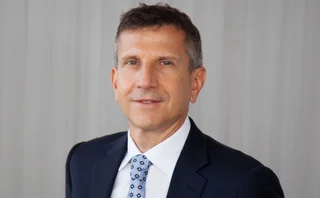
Special Report Carbon Trading - Africa CDM - Africa's green potential
Home to only 2% of the world's CDM projects, Africa is lagging way behind countries such as India, China and Brazil. Katie Holliday looks at why this is and asks whether there is now investment potential in the African CDM market
Since its creation in 2005 as part of the Kyoto Protocol, the Clean Development Mechanism (CDM) has spurred the creation of 1,403 registered emissions reductions projects worldwide. Set up to allow industrialised countries to invest in emissions reduction projects in developing countries and gain Certified Emission Reductions (CERs), the CDM has been used most widely in China, which is home to 29.7% of all CDM projects. India has 28% of CDM projects, while Brazil has a 10.7% market share. But only 2.07% of CDM projects are based in Africa, according to the United Nations Framework Convention on Climate Change (UNFCCC).
Political risk, economic problems and stagnated infrastructural and technological developments have all been blamed for Africa's slow start in the CDM market, as has its relatively low emissions. But the potential for CDM development is strong, particularly in the largest countries, such as South Africa, Nigeria and Kenya, say experts. And although there are substantial barriers to be overcome in the least developed countries, industry experts are optimistic about the potential for developing projects in these countries too. Developers, climate change bodies and governmental committees are working hard to alert investors and the carbon community to Africa's untapped potential.
Energy imbalance
On the face of it, though, it's not hard to see why African countries aren't generally the first choice as a location for CDM projects.
First, relatively speaking, Africa does not have huge amounts of emissions to reduce. The continent has one of the largest energy deficits in the world, with 500 million of its 922 million population still lacking access to electricity, according to a World Bank report on the African CDM market. As a result, Africa's total emissions are 680 million tonnes of carbon dioxide a year, compared to China's 5.1 billion tonnes per year, according to the US Energy Information Administration (EIA). This relatively low emissions rate mean there is less opportunity for emissions reduction projects.
"Emission reduction potential is directly linked to economic potential. Therefore, if a country has a less active economy there is less potential to do these kinds of projects," says Henk Sa, head of project development in Africa at Ireland-based project developer EcoSecurites. "Most countries in Africa are agriculturally based and not very heavily industrialised - therefore there is little potential to reduce emissions," he says. However, he points out that specific regions in Africa with the most active economies, such as South Africa, Nigeria and Kenya, have substantial amounts of emissions to reduce. He also believes smaller African economies still offer opportunities for emissions reductions. "I'm not ruling out the potential of the smaller countries either," he adds. "Their potential is just on a smaller scale."
There are currently 29 registered CDM projects in Africa and around 90 projects in the pipeline, most of which are based in North Africa (see table for full list). The larger oil- and gas-producing countries are home to nitrogen dioxide reduction and gas flare reduction projects, while the smaller agricultural countries tend to host the smaller forestation and afforestation projects and biomass projects.
Many African least-developed countries (LDCs) hold potential for programmatic projects, experts say. These projects, which are yet to be accepted into the scheme, aggregate a number of smaller emission reduction activities, such as energy-efficient lightbulbs being used in an entire village. North Africa has the potential to develop wind and solar projects, according to Will Greene, carbon project manager at carbon consultants Point Carbon.
Late starter
Daniele Violetti, lead officer for CDM registration and issuance at the UNFCCC, says Africa's relatively low level of CDM projects does not reflect the continent's potential for CDM development. "Roughly 2% of the CDM market is clearly not satisfactory," he states. "But the reason for Africa's minimal share is because Africa was slow moving at the start of the CDM market, in terms of building capacity and institutional frameworks, but this is now changing," he adds.
It's easy to see why, for many African nations, emissions reductions projects would not be a priority when there are so many social and political issues they need to address. "The key reason for lack of capacity development in Africa is because there are so many other pressing priorities, like AIDS and poverty," says Mike Bess, head of policy and strategy in Africa and Bulgaria at project developer Camco. "It's difficult for any government not to prioritise them first," he adds.
As a result, political uncertainty and bureaucracy have also hindered the implementation of the CDM structure. Many existing Designated National Authorities (DNAs) - which are bodies granted responsibility by the CDM Executive Board to authorise and approve projects in their own country - are not operating to their full extent and in certain countries are yet to be established, despite the continent's ratification of Kyoto.
Regulatory mechanisms
In addition, many developers working in Africa at the moment complain that dealing with the CDM regulation is too complex and does not fit well with African business methodologies, according to Sa. "Some of the methodologies are designed to fit western business methods, but there is a discrepancy over what is realistic in terms of how you can monitor a project in Africa versus what is required by the CDM," he says.
Sa says this is a huge stumbling block faced currently by African CDM project developers. "The solution, if any, is that there should be less focus on academic, expensive and high-tech instruments to measure the emission reductions of a project, which puts off African agriculture from introducing emissions reduction projects," he says.
But Sa does not see this an issue that will be resolved soon. "It doesn't look like this is changing. I don't think the CDM EB is looking to resolve this problem at the moment - the methodologies seem to point in the other direction. The exact calculation of the amount of carbon credits seems to be the holy grail of the CDM," he says.
Even if project developers can cope with the regulatory mechanisms, there is often a lack of technology and infrastructure.
"Most countries in Africa simply don't have the industrial processes and infrastructure in place to facilitate CDM projects," says Simon Dent, head of European power and gas trading at BNP Paribas.
"It is more difficult to implement a wind project in Africa than in China," says Sa. "There are all sorts of practical constraints involved. Africa doesn't have such a sophisticated infrastructure to transport materials to the site and accurately measure the velocity of wind power created by the farm," he says.
The need for local expertise
In theory, a CDM project is designed to provide a developing country with more advanced technology, but this is difficult to achieve without the proper infrastructure required to implement the technology.
In addition, it's difficult to source locals with the necessary technical expertise. "Technical competency is an issue in Africa," says Point Carbon's Greene. "There are few local consultants with the technical competency to draft project design documents (and then) source and install the technology."
If the infrastructure and technological challenges are not overwhelming, the next difficulty for project developers is that of financing and cost. There are additional costs for developing African CDM projects in comparison to similar Chinese projects, according to Greene. The main one is local financing, as interest rates tend to be far higher in African nations than in China. There are few local validation companies so experts often need to be flown in, creating extra travel costs of around EUR3,000 to EUR5,000 per project, he says.
Financing is only likely to become harder now due to the financial crisis, which means that the high-risk capital that was previously available to project developers is much harder to find. "Aside from governments, investors who would look at high-risk opportunities in Africa are no longer there," says Greene.
Sa agrees that the global financial crisis will take its toll on Africa's progress. "I do expect a slowdown in new projects being initiated in Africa as a result of the financial crisis. It's going to be hard to raise capital at an affordable rate."
A further bone of contention lies with the uncertainty over a future climate agreement. Whether or not the Kyoto Protocol will be extended has led developers to question the long-term value of CERs produced by CDM projects.
"The timeline to reach the end of the Kyoto period - 2012 - has now become too short. Project developers might be put off by the fact that that in the time it takes to get a project registered and constructed, which can take up to five years, there might not be a guarantee that carbon credits will have that long-term value," says Sa.
Signs of progress
However, despite the array of obstacles facing the African CDM market, programmes and initiatives designed to heighten the awareness of opportunities in Africa are helping the market progress.
"It's important to emphasise what has already been done in terms of African CDMs. The Nairobi Framework and the work done by the World Bank and partner agencies, including the UNFCCC, the UN Development Programme (UNDP) and the UN Environment Programme (UNEP), has heightened awareness of African opportunities," says the UNFCCC's Violetti.
The Nairobi Framework was drawn up at the Conference of Parties UN summit in 2006. UN-led organisations collaborated with the World Bank Group and the African Development Bank to find ways of raising the awareness of CDM potential in Africa. It focused on building and enhancing DNAs, building capacity for projects, promoting investment opportunities, improving information sharing and inter-agency co-ordination.
And in September last year, the World Bank issued a report on Sub-Saharan Africa's untapped potential for investment in CDM projects and promoted the importance of climate investment funds. According to the World Bank, "there is tremendous potential locked up in these African countries." However, the report acknowledged the barriers to success. "Market access requires appropriate infrastructure planning and policies to overcome logistics bottlenecks. Local skills required to run mature, clean technologies must be developed," the report said.
EcoSecurities' Sa is confident about Africa's future potential for CER production. "I expect to see a substantial growth in the production of CERs coming out of Africa, because the projects in the pipeline now will continue to generate credits, and once this production matures, CER generation will increase," he says.
Increased CER generation will help to drive more investor and developer interest to Africa. Additionally, the African CDM market may benefit from a helping hand from the EU.
"There are opportunities (in Africa) for afforestation, forestation and programmatic projects," notes Camco's Bess. "The problem is, these are not yet recognised by the European Union Emissions Trading Scheme (EU ETS), but there is a strong possibility that they will be soon," he adds.
BNP Paribas' Dent agrees. "If agricultural and forestry projects are integrated into the scheme, that should up Africa's emissions reduction potential substantially," he says.
And in addition to accepting a broader scale of projects into the EU ETS, there are other incentives the European Union can facilitate to help the LDCs in Africa, according to Greene. "There needs to be high-level structured political support from the EU, and by that I mean there needs to be some way of favouring African projects under the CDM," says Greene. "Recently the EU has been contemplating giving preference to the CDM credits produced in the least developed countries, most of which are in Africa. This would provide a commercial incentive for companies to identify business opportunities in these very marginal high-risk countries," he says.
Gaining a voice at a regulatory level will also be a step towards a more successful CDM market, according to EcoSecurities' Sa. "African industry needs to consolidate its position and gain representation at EB level. They could do this by designing a more organised process to make themselves heard. There is no formal process at present," says Sa.
"The CDM process is one of learning by doing," says the UNFCCC's Violetti. "The question is not - does Africa have potential? It clearly does; it is building the capacity to take advantage of that potential that is crucial. Progress has been recorded already, but in the next two years I expect to see many more projects emerge from the pipeline," he adds.
Only users who have a paid subscription or are part of a corporate subscription are able to print or copy content.
To access these options, along with all other subscription benefits, please contact info@risk.net or view our subscription options here: http://subscriptions.risk.net/subscribe
You are currently unable to print this content. Please contact info@risk.net to find out more.
You are currently unable to copy this content. Please contact info@risk.net to find out more.
Copyright Infopro Digital Limited. All rights reserved.
As outlined in our terms and conditions, https://www.infopro-digital.com/terms-and-conditions/subscriptions/ (point 2.4), printing is limited to a single copy.
If you would like to purchase additional rights please email info@risk.net
Copyright Infopro Digital Limited. All rights reserved.
You may share this content using our article tools. As outlined in our terms and conditions, https://www.infopro-digital.com/terms-and-conditions/subscriptions/ (clause 2.4), an Authorised User may only make one copy of the materials for their own personal use. You must also comply with the restrictions in clause 2.5.
If you would like to purchase additional rights please email info@risk.net
More on Awards
Environmental products house of the year: ENGIE
ENGIE is driving change in energy transition, with a strong focus on renewable energy and the liberalisation of power markets in Apac, which presents significant long-term growth opportunities. In recognition of its efforts, ENGIE GEMS has been named…
Natural gas/LNG house of the year: ENGIE
ENGIE continues to expand its services to better serve firms in Apac dealing with the challenges of energy risk management and supply
FRTB management solution of the year: Bloomberg
Amid the diverging timeframes and complex requirements of FRTB, Bloomberg offers a consistent, comprehensive and customisable solution for Apac banks preparing for implementation
Newcomer of the year: Topaz Technology
Jon Fox and former colleagues formed Topaz Technology in 2015. Having seen many different systems and, in some cases, written and built a few themselves, there was always something missing, leading them to build a system that unifies risk reporting and…
Technology vendor of the year: Murex
As a technology vendor, Murex places adaptability front and centre of everything it does, constantly enriching its MX.3 platform to ensure institutions can respond to new market opportunities as soon as they spot them
Currency derivatives house of the year: Deutsche Bank
Asia Risk Awards 2024
Interest rate derivatives house of the year: Standard Chartered Bank
Asia Risk Awards 2024
Derivatives house of the year, Taiwan: CTBC Bank
Asia Risk Awards 2024







